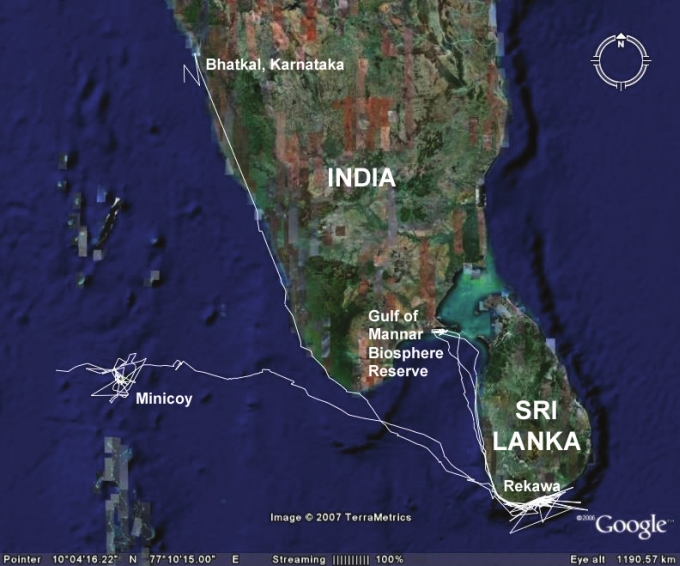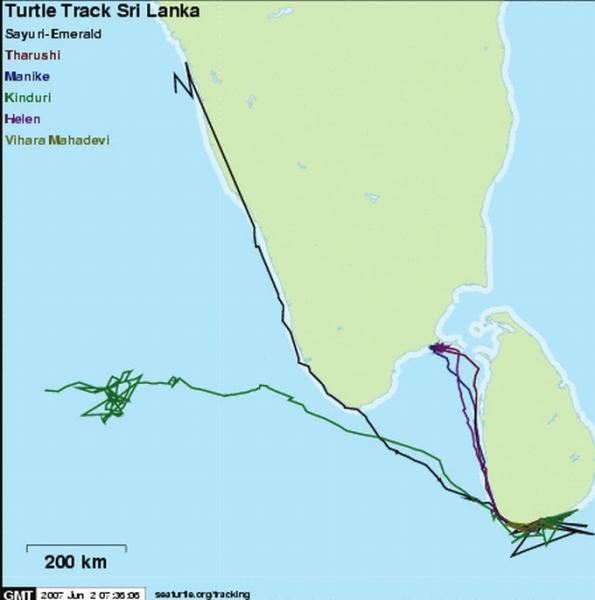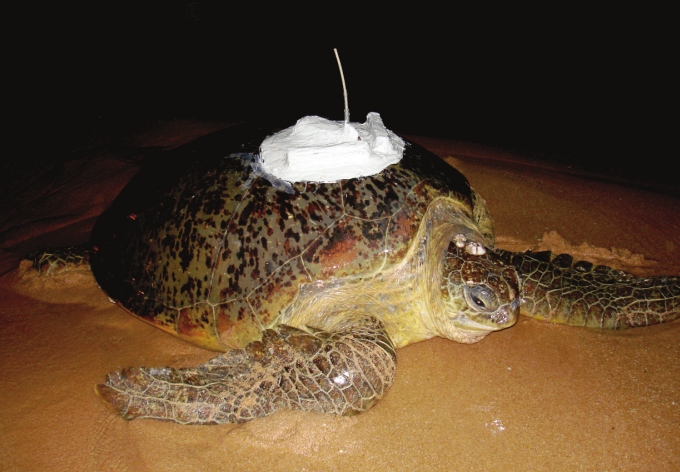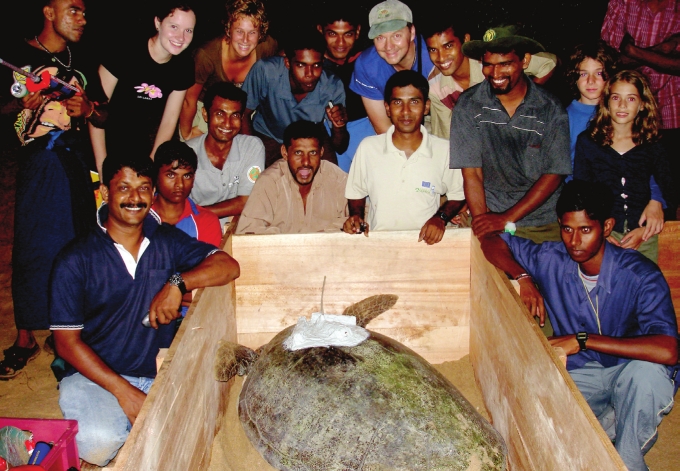Peter Richardson
Species Policy Officer, Marine Conservation Society, Unit 3, Wolf Business.Park, Alton.Rd, Ross.on.Wye, Herefords HR9 5NB
E-mail: peter{at}mcsuk.org
Presented to the BCG Symposium at the Open University, Milton Keynes, on 12th June 2007
Between 30th July and 8th August 2006, six female green turtles (Chelonia mydas) were fitted with Kiwisat 101 satellite transmitter tags shortly after nesting on Rekawa beach on the south coast of Sri Lanka as part of the Convention on Migratory Species Memorandum of Understanding on the Conservation of Marine Turtles and their Habitats of the Indian Ocean and South East Asia (IOSEA) ’IOSEA Year of the Turtle’ celebrations. The tags were attached by staff from the Marine Conservation Society (MCS), the Turtle Conservation Project (TCP) Sri Lanka, Nature Friends of Rekawa (NFR) and the Department of Wildlife Conservation (DWC) Sri Lanka, with the help of several enthusiastic and capable TCP and UN volunteers.
Online tracking
The six turtles were then tracked online using Seaturtle.org’s excellent Satellite Tracking and Analysis Tool (STAT) (Coyne & Godley, 2005) at a dedicated project site www.mcsuk.org/marineworld/trackturtle. The tags transmitted for between 61 and 169 days, with the last accurate transmission from the last remaining active tag received on the 23rd January 2007. Almost 70 years after the publication of Deranyagala’s irst observations of nesting marine turtles in Sri Lanka (Deranyagala, 1939) the data generated by this project represents the irst detailed insight into the inter-nesting behaviour, migration and foraging grounds of the female green turtles nesting on the island’s shores.

Location of Tracking Area
The turtles’ journeys
The first turtle to be tagged (Helen) immediately began her post-nesting migration after her release, but four of the other turtles appeared to consistently inter-nest (activity between nests) in inshore waters adjacent to Rekawa beach. This suggests that these local waters, some of which lie within the recently designated Wildlife Sanctuary at Rekawa, provide key inter-nesting habitat for the female green turtles during the nesting season. The other turtle (Devi) inter-nested at Habaraduwa after nesting at Rekawa, which is an unprotected site some 70km west along Sri Lanka’s coast. She stayed there for 4 weeks after her last nesting activity at Rekawa before her tag failed unexpectedly early. Given that green turtles tend to nest approximately every two weeks, this turtle’s 4 week stay at Habaraduwa suggests that this may have been her resident foraging ground. Alternatively, she may have been resting there in preparation for migration away from Sri Lanka.
The other five turtles migrated to three general areas after completing their last nesting activities at Rekawa. This indicates that, as with green turtle breeding populations elsewhere, the nesting females’ resident foraging grounds are diverse and distant from Rekawa. Three turtles (Helen, Tharushi and Manike) migrated to separate foraging grounds in the Gulf of Mannar Biosphere Reserve (GoMBR) off the coast of Tamil Nadu, India, located over 400km (straight-line) northwest of Rekawa. They stayed at speciic sites within the GoMBR for between 1 and 3 months before their tags failed, suggesting that their resident foraging grounds are within the GoMBR.

Turtle migration routes tracked from Rekawa.
Another turtle (Kinduri) migrated to Minicoy, the most southerly of India’s Lakshadweep Islands and some 927km (straight-line) northwest of Rekawa, and stayed there for 1.5 months before her tags failed. Again, this suggests she had arrived at her resident foraging grounds. Another turtle (Sayuri) migrated up the west coast of India to an area off Bhatkali, Karnataka, some 1,137km northwest of Rekawa, and stayed there for 1 month before her tag failed. While a sample of six turtles cannot be representative of the hundreds of green turtles that nest at Rekawa, these initial results suggest that India’s territorial waters could provide key foraging habitat for a signiicant percentage of Sri Lanka’s nesting green turtles. It is interesting to note that, once the turtles reached their foraging grounds, the tags lasted for between 1 and 3 months. This is probably due to the fact that green turtles rest at night under coral heads when at their resident foraging grounds. They will also rub and scratch their carapaces on coral heads and rocks to remove epibionts, inevitably putting the satellite tags at risk. It seems that the current design of the tags and attachment cannot take this kind of treatment for longer than 3 months!

Green turtle ‘Helen’ showing epibionts on her head.
The five turtles that migrated away from Sri Lanka appeared to use the coast of Sri Lanka as a navigational cue in the early stages of the migration. The turtles did not appear to be foraging during this stage of their migrations and were swimming approximately 45kms per day. However, they were swimming through heavily ished inshore waters and so ran the risk of accidental entanglement in nets and longlines set in the water column along their migration route (Kapurusinghe & Cooray, 2002). In addition, the three turtles that migrated to the GoMBR crossed the heavily ished waters of the Gulf of Mannar, an area known to be a local hotspot for accidental entanglement of marine turtles in fishing gear (bycatch), as well as direct exploitation of turtles for their meat (Kapurusinghe, 2006).

The tag team with ‘Tharushi’.
Little is known about turtle bycatch in the GoMBR, but available literature suggests that these turtles may not be exposed to the high levels of directed exploitation reported elsewhere along the Tamil Nadu coast, largely due to the State protection measures afforded within the Reserve (Bupathy & Saravanan, 2006). The turtle that migrated to Minicoy may also be less likely to be exposed to directed take than elsewhere in the Lakshadweeps, at least from local ishers, as the Minicoy community is predominantly Muslim and relatively wealthy, and so historically not heavily dependent on a turtle harvest (Bhaskar, 1978; Tripathy, Shanker & Choudhury, 2006). The turtle that migrated to the coastal waters of Karnataka appeared to be resident in an area with some artisanal ishing, although little is known about marine turtle bycatch there (Sharath, 2006).
The provisional indings of this project reinforce previous TCP work and highlight the potential threat that Sri Lanka’s nesting turtles face from the country’s inshore isheries. Furthermore, the indings suggest that both India and Sri Lanka have important roles to play in conserving the countries’ shared and endangered green turtle populations. These roles could be reinforced via bilateral cooperation through regional agreements such as IOSEA.
MCS and the TCP hope to carry out further assessments of the environmental sustainability of selected Sri Lankan isheries starting in 2007. In addition, MCS will be taking another four satellite transmitters to attach to green turtles at Rekawa with the TCP in June 2007. The data from all the tags will be analysed by Peter Richardson at the MCS and Drs Brendan Godley and Annette Broderick at the University of Exeter for publication co-authored by all project partners at a later date.
The 2006 tagging project was filmed by a BBC Natural History Unit crew and features in a documentary about the TCP’s pioneering work broadcast in Summer 2007 as part of a BBC lagship series entitled ‘Saving Planet Earth’. If you would like to support the additional satellite tagging or ind out more about the BBC ’Saving Planet Earth’ series, go to www.mcsuk.org for more information.
Acknowledgements
Many thanks for the invaluable time and support from various members of staff at the MCS, TCP, NFR, DWC, Seaturtle.org and the University of Exeter, as well as the TCP and UN volunteers, without whom this project would not have been possible. Many thanks also to the project sponsors, including Defra via the IOSEA Sea Turtle Agreement Secretariat, the Deep Aquarium in Hull and Hurtigruten, and finally to Paul Appleby and the BBC NHU for lending their weight to the momentum.
References
Bhaska, S. (1978). Marine Turtles in India’s Lakshadweep Islands. Marine Turtle Newsletter, 8: 5.
Bhupathy, S. & Saravanan, S. (2006). Marine turtles of Tamil Nadu. In: (eds) Shanker, K. & Choudhury, B.C. Marine turtles of the Indian Subcontinent. Universities Press (India) Private Ltd.
Coyne, M.S. & Godley, B.J. (2005). Satellite Tracking and Analysis Tool (STAT): An Integrated System for Archiving, Analyzing and Mapping Animal Tracking Data. Marine Ecology Progress Series 301: 1-7.
Deranyagala, P. (1939). Tetrapod reptiles of Ceylon. Vol. 1. Colombo Mus. Nat. Hist. 412pp.
Kapurusinghe, T. & Cooray, R. (2002). Marine turtle by-catch in Sri Lanka. TCP Survey report for CMS, ISBN 955-8758-01-9.
Kapurusinghe, T. (2006). Status and conservation of marine turtles in Sri Lanka. In: (eds) Shanker, K. & Choudhury, B.C. Marine turtles of the Indian Subcontinent. Universities Press (India) Private Ltd.
Sharath, B.K. (2006). Sea turtles along the Karnataka coast. In: (eds) Shanker, K. & Choudhury, B.C. Marine turtles of the Indian Subcontinent. Universities Press (India) Private Ltd.
Tripathy, B., Shanker, K. & Choudhury, B.C. (2006). Sea turtles and their habitats in the Lakshadweep Islands. In: (eds) Shanker, K. & Choudhury, B.C. Marine turtles of the Indian Subcontinent. Universities Press (India) Private Ltd.
Testudo Volume Six Number Four 2007
Top




